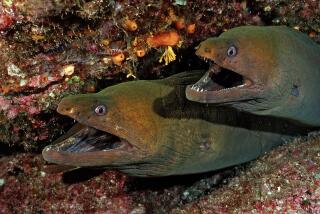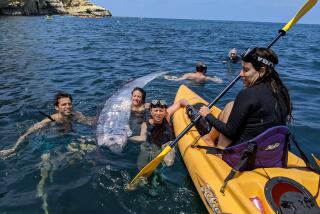Giant oarfish carcass off Catalina among the biggest in recent years
The 18-foot oarfish found dead off Catalina Island over the weekend was rare not only because they live nowhere near coastlines, but also because it was among the biggest reported in nearly 20 years.
A 12-foot oarfish washed ashore in Malibu in 2010, but it was a much smaller -- and thinner -- variety with its silvery scales and a scarlet red dorsal fin.
In recent years, researchers have captured video of an oarfish swimming deep underwater in the Gulf of Mexico and spotted one swimming not far from the shore in Baja California. But not since a group of Navy SEALS found a 23-foot-long oarfish off Coronado in 1996 has such a large oarfish been reported.
Jeff Chace, program director at Catalina Island Marine Institute, said it took about 15 people to lug the serpent-like “leviathan” onto shore after a snorkeler spotted the carcass in about 20 feet of water.
“This is a once-in-a-lifetime discovery,” Chace said.
Rick Feeney, ichthyology collections manager at the Natural History Museum of Los Angeles County, said giant oarfish only “wash up occasionally” because they’re typically in deep open ocean.
When oarfish come closer to shore, Feeney said it may be a sign of distress. They could be starving, disoriented or landed in shallower water because of a storm.
“They’re usually in the deep ocean, away from land,” Feeney said.
Giant oarfish get up to about 27 feet maximum, he said, adding that stories of them reaching 50 or more feet haven’t been verified.
One of the museum’s existing specimens, a 14-foot oarfish recovered from Catalina Island in 2006, is well-known to visitors. It is suspended in alcohol in a giant case in the grand foyer.
“Not a whole lot is known about them, because they are sort of secretive,” Feeney said. “We’re slowly finding out more about them.”
VIDEO: Ethereal oarfish caught on tape
The Catalina Island Marine Institute, meanwhile, is awaiting results of several samples sent out to researchers of its 18-foot specimen. Until then, staff members say they lack the capacity to keep it refrigerated.
In the absence of preserving the carcass, the institute may go with one option on the table: Bury the dead fish in 3 feet of sand, then let it decompose over a couple of months. After that, the skeleton could be exhumed and mounted.
ALSO:
LAX dry ice bomb suspect held on $1-million bail
L.A. City Council to hear complaints from transportation workers
‘Rally Bear’ banned from Dodger Stadium: ‘I got my point across’
Twitter: @aribloomekatz | Facebook
More to Read
Sign up for Essential California
The most important California stories and recommendations in your inbox every morning.
You may occasionally receive promotional content from the Los Angeles Times.











